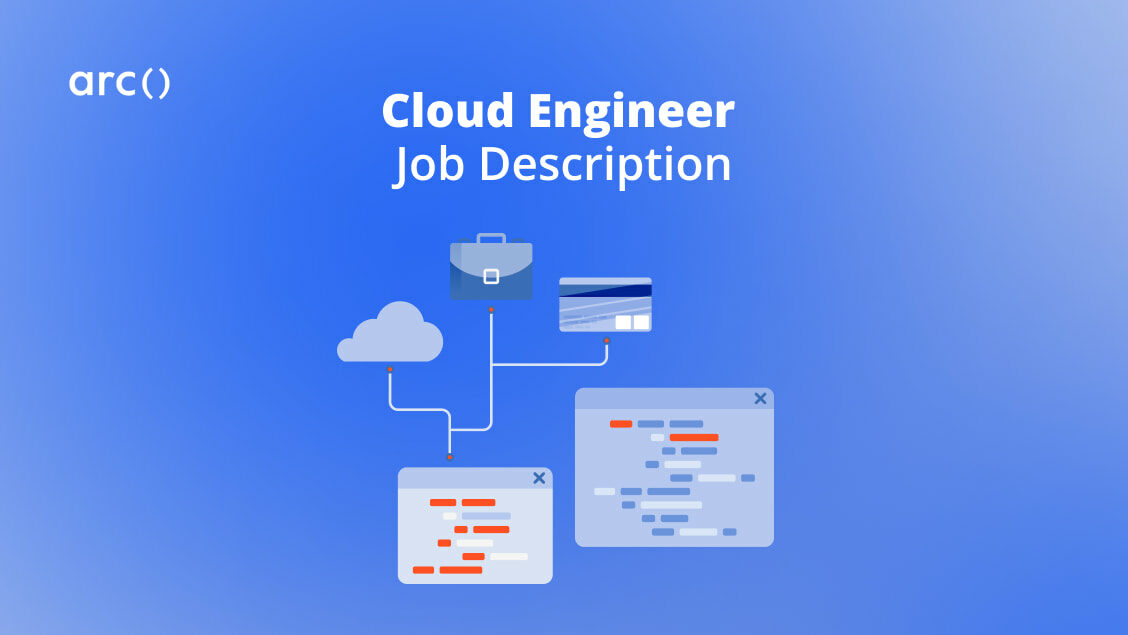The cloud market is hot. According to stats, this technology sector touched $274.79 billion in the year 2020 and is expected to reach $1.25 trillion in 2028.
Naturally, the demand for a cloud computing engineer is also witnessing an aggressive boom. As a result, more and more hiring companies are looking for cloud professionals to be part of their organizations.
However, finding a cloud engineer for your company isn’t a piece of cake. It isn’t easy to compete with big companies and successfully grab a competent cloud services engineer for your team. But it’s still possible — and having a killer cloud engineer job description is your first step.
A comprehensive and compelling job description can create a huge difference. This article will help you create the best cloud engineer job description.
What we’ll cover:
- An example of a great job description
- Complete guidance on how to write an attractive job description
- Advice and tips to attract the best cloud engineers
- Answers to all your common questions regarding career and job descriptions for cloud engineers
If you are ready to explore this topic, dig right in!
Looking to hire the best remote talent? See how Arc can help you:
⚡️ Find the world’s top developers, designers, and marketers
⚡️ Hire 4x faster with fully vetted candidates
⚡️ Save up to 58% with global hires
Hire top talent with Arc risk-free →
Sample Cloud Engineer Job Description Template
A template can help you understand the structure of a job description in a better way, and so below, we have shared a sample for you. Of course, you can use this template as you please and make changes where required.
Senior Cloud Engineer, Principal Google Cloud Infrastructure (Remote) About Us At XYZ Tech Solutions, cloud computing is an integral part of our cloud infrastructure. We use this IT solution to create a modern, innovative and automatic way to pursue next-level innovation. As part of our company, you will be working as a cloud engineer with expertise in designing and developing large-scale cloud-based projects in GCP (Google Cloud Platform). What You'll Do As a part of your Google Cloud Platform cloud engineer responsibilities, you will work with your team to design and implement different cloud-based IT solutions for our organization. Further, you will monitor and follow best strategies and practices to maintain the cloud infrastructure. You will also be responsible for guiding your team members to build solutions with high cloud competencies. Responsibilities • Identify and then implement the best cloud solutions for the company • Document all best practices during the deployment of applications • Work with team members as their leader and mentor and help them build competent cloud solutions • Ensure the high quality of code and application scale and performance • Management of cloud environments and their security according to the company's guidelines • Educate team members regarding the deployment of different cloud-based initiatives and offer associated training • Employ different problem-solving skills before different challenges start impacting the productivity of the business • Should be able to oversee database management Must-Have Qualifications • Bachelor's degree in mathematics, computer science, or information technology • 3+ years of experience in designing, architecting, and implementing different Google Cloud Platform-based solutions • Experience in other areas such as business intelligence, machine learning, advanced analytics, and database architecture • Strong problem-solving and leadership skills • An ability to work for at least five hours every day • Experience with operating systems, including MAC OS and Window • Expertise and know-how of Python and Java languages Nice-to-Have Qualifications • GCP, AWS, or Azure certifications • Good knowledge of RPC, REST, and API • Experience working with SaaS offerings Compensation and Benefits • Competitive base salary, $131,409- $153,00 • Paid parental leave • Paid vacation • Stipend for remote work • Insurance for medical, dental, and vision • Retirement plans Get In Touch We assure you that our organization will help you elevate your cloud engineer career to a new, more significant level. Our team consists of professionals from different parts of the world, and each member can help contribute to your work life. In addition, our strong culture and focused vision will provide you with an opportunity to learn new things and play your role as a professional cloud engineer. If you want to be a part of our fantastic team, get in touch today!
It is important to note that you can easily customize this sample according to your company’s rules and regulations.
You can add more sections to your job description if that helps to attract competent and better candidates for your cloud engineer position.
Check out our entire set of tech job descriptions and choose the one which fits your hiring needs best:
- Software Engineer Job Description
- Python Developer Job Description
- Front-End Developer Job Description
- Angular Developer Job Description
- Back-End Developer Job Description
- Cloud Architect Job Description
- JavaScript Developer Job Description
- AWS Cloud Engineer Job Description
- AWS Cloud Practitioner Job Description
- AWS Cloud Architect Job Description
- Scrum Master Job Description
- Full Stack Developer Job Description
- Node.js Developer Job Description
- Cloud Engineer Job Description
- DevOps Engineer Job Description
- Web Developer Job Description
- React Developer Job Description
- Ruby on Rails Developer Job Description
- Agile Product Owner Job Description
- Agile Project Manager Job Description
- Remote Developer Job Description
Or, say goodbye to writing job descriptions altogether with HireAI. Discover top remote developers instantly without manual searching and screening. Try HireAI now!
How to Write a Software Engineer Job Description
By now, you should have an idea of what to include in a cloud engineer job description.
If you’re ready to start writing, keep these basics in mind:
- Front-load the most important information — don’t make the candidate work hard to find it
- Optimize for skimming — use bold text, bullet points, and subheadings
- Keep it to the point (your potential applicant doesn’t want to read a novel)
- Consider how it looks in context on the job board — and when placed next to similar job ads (you want yours to look even more attractive)
- Proofread before publishing!
Now let’s move on to considering each component of the job description in greater detail. Read on!
Job Title
One of the first things you should consider is the job title. Without it, it is impossible to attract suitable candidates. What this means: a job title should be compelling. No one will click into your job description from the search results if it isn’t.
It’s a war for attention, and your aim is to win.
We would always encourage you to go for short titles, as long as they serve the purpose. For instance, the “Cloud Engineer” title contains only two words, but it fails to draw a broad picture. For example, what kind of cloud engineer does a company need, and should it be a senior with extensive experience or a beginner?
On the other hand, a title such as “Senior Cloud Engineer – AWS Specialist – Remote” may not be concise, but at least it delivers the message. This job title specifies the seniority level of the candidate required and, at the same time, mentions the specialization required.
A title longer than this might be too detailed for a job description. However, if you want to include a comprehensive job title in your description, you can also choose to mention the following things:
- Languages or technologies required
- Company’s name
- Employment type
If you plan to hire a cloud engineer intern, your job title should include “Intern” to highlight the experience level required. Done with picking your job title? Let’s move to the next part of your job description.
Company
Before a candidate applies for a position in your company, they will obviously want to know about you. There are so many tech companies in the world, but what are the things that make you different from the rest? For example, do you excel in providing a comfortable employee experience, or is your salary structure competitive?
Instead of writing paragraphs explaining your company, keep the introduction precise and focus on points that make you stand out. Things like where your company is based, what you’re working on, and your tech stack are good places to start.
But keeping the description short is also appreciated by cloud engineers. Direct potential applicants to the About Us page on your website to know more.
Role Summary
Role (or job) summary is an important section — it gives your potential candidate insight into what they’ll be doing if they join your company. This can also be kept simple: just ensure you mention their basic responsibilities and the part they will play in your company’s engineering team.
Think of this section as to how your future cloud engineer might share with someone when asked about what they do in your company. But, again, don’t keep it too long and simply focus on the main tasks that a cloud engineer is expected to achieve.
The role summary of a cloud computing engineer won’t be the same as a cloud platform engineer. So, ensure you are clear about the expertise of both these job positions, and you’ll end up with a more appropriate candidate pool.
Responsibilities and Duties
This part answers the question: what will your cloud engineer do?
You have two options here: combining this information into the role summary, or using a separate section. Whichever one you choose, it’s important to optimize for readability. Most people will choose to list the responsibilities and duties as a bullet point list.
Keep things simple: cover the tools your cloud engineers can use and then mention some general activities they’re expected to perform. You should also highlight specific processes and solutions that your new engineer would be responsible for implementing.
Here is a great example of a cloud engineer job posting on LinkedIn:
Responsibilities:
- Maintain high availability cloud infrastructure
- Develop, implement, and maintain configuration of underlying cloud services, including but not limited to AWS, Cloudfront, S3, SNS, and SQS,
- Administer existing and deploy new AWS EC2 instances, and related infrastructure
- Interacting with teams and customers in different time zones for ensuring 24/7 support
- Developing scripts for deployment, monitoring, reporting, and alerts, ensuring a robust, redundant, scalable 100% uptime infrastructure.
- Analyze security threats and applicability to customer environments
- Triage and resolve technical and user issues
Your goal here is to have your potential applicants be able to identify themselves with doing these tasks. This helps them decide whether or not they’re a good fit for the role.
Must-Have Skills and Experience
Onto skills and experience. Unless you’re hiring an intern, it’s natural to expect your applicants to bring specific skills to the table. But a word of warning: be realistic here. If you are looking for an intermediary-level cloud engineer, don’t require them to have 10 years of experience in this field. Aside from not making sense, it can also reflect poorly on you.
The same job posting above provides an example of what you might mention:
Required Skills & Experience:
- Minimum of 3 years of demonstrated experience designing, developing and maintaining cloud applications
- Experience establishing and employing Continuous Integration practices
- Experience effectively communicating in an Agile environment with the team, managers, business units and internal and external stakeholders.
- Artifact/Code Management – Azure DevOps (VSTS) is a plus
- Experience deploying infrastructure/applications with Azure Devops and other tools including Terraform.
Nice-to-Have Experience and Skills
This section should include any additional skills or experiences that might help you differentiate one candidate from another. For instance, if a cloud engineer candidate has specific experience in your preferred processes and tools, they might have higher chances of being accepted for this position.
Additionally, a candidate with some leadership role experience can add good value to your team.
Just remember: every time you add another skill/experience to your job description, you potentially cause more applicants to self-exclude. So think carefully about what you really need in your team, rather than a pie-in-the-sky wishlist. Any “less necessary” skills and experience should always be listed in this section, rather than in Required Skills and Experience.
This Apple job posting example mentions some nice-to-have skills in their preferred cloud traffic engineer:
BONUS EXPERIENCE AREAS: • AWS, GCP, and/or Azure • Kubernetes, Nomad, Mesos, or equivalent • Certificate Management • Netscaler, F5, NGINX, Envoy, or equivalent • Internet facing edge termination • Content Delivery Networks • Puppet, Chef, or equivalent • Proactive capacity planning
Requirements for Certifications or Education
Speaking of causing applicants to not apply due to too many requirements, consider whether you really need specific educational attainments or certifications. This is because many cloud engineers are self-taught, and they may not have an extensive formal educational background in cloud engineering.
But if you truly require certain certifications or minimum formal education, this is the place to mention them.
Working Location and Time
Unfortunately, many job descriptions fail to mention the time and location. The result: wasting the time and effort of both the company and the potential candidates. Not a great start.
If you want your cloud service engineer to work remotely, you should mention that in your job description. Also, include any instances in which you may need their presence at the office. This is also a chance to give some insight into your workplace culture, e.g. if you hold on-site team bonding activities or not.
If the job requires on-site presence (or hybrid), you’ll need to specify the location. At a minimum, this needs to be the city, but more specifics are better. Does the company offer any travel benefits? If so, mention these too.
Additionally, don’t forget to mention the hours you want your cloud engineer to work for you. For example, if you want a part-time engineer, highlight that with the number of hours you expect them to work in your job description.
Also, if you hire cloud engineers in a specific country with a different time zone, ensure to highlight the timings in that area. If your engineering team is geographically distributed, but there are times of the day when everyone needs to be online, mention this too. Allowing your developers to set their own working hours is regarded favorably by candidates.
Finally, if possible, give your applicants an idea of the number of hours or days they might be expected to work outside their regular timings. This will help the candidates decide whether the job matches their expectations and lifestyle.
Compensation, Perks, and Benefits
Onto the details: what’s the salary package? Do you need to disclose specifics?
Being transparent about the salary is a good way to make your job description stand out. However, you can always write a range rather than an exact salary — although avoid making the range so large that it’s meaningless. If you’re not sure what to offer, check job boards to ensure your offer is competitive.
But it’s not just about salary. Given it’s an employee’s market, you should make the whole compensation package tempting. Here are some other things that you can include in this section:
- Equity
- Health coverage
- Any stipends (e.g. home office setup, gym)
- Performance bonus
- Retirement program
- Leave policy
- Subscriptions
- Reimbursement of tuition
- Any other benefit
Looking Ahead: 1 month, 3 months, 1 year, etc.
A more modern trend in job descriptions is giving your potential applicants a chance to visualize their onboarding process and your expectations of what they will achieve. Ways of doing this include “Your first 90 days” or “What you will achieve in XYZ timeframes.”
You don’t have to make this section a part of your job description; however, if you feel that mentioning your expectations from the candidate will help you find the right people, add it in!
You can mention the different things they should achieve within specific time frames after starting in the role. This can include any certifications or experiences that will upgrade their career.
Other Sections You Can Include In Your Job Description
As long as you have the above areas covered in your job description, you’re ready to go public and start finding candidates. Congratulations!
However, if you want to make your job description more detailed or longer, you can add the following sections as well:
How to Apply
Most job boards will allow you to attach your resume and cover letter under the job description. However, if your company wants the candidates to send their resumes through an email address, make sure to mention that.
Company Culture
If you aren’t satisfied by the introduction of your company you have given below, add another paragraph or two to show off the vibrant culture that you are proud of.
Point of Contact
It is always wise to share the contact information of a person or people the candidate may want to contact to answer any questions regarding the cloud engineer job position.
Tech Stack
Many cloud software engineers love to know the tools they’ll use after joining your company. So, to accommodate them, you can always mention a few.
Ideal Candidate
Under this heading, you can mention some unique attributes you want your potential job candidates to have. For instance, if you want an expert in AWS, IBM Cloud, or specifically in Microsoft Azure, you can mention that here.
The Type of Employment
Don’t forget to mention whether your job posting is for a full-time or part-time job. Besides, if you want to hire a cloud engineer intern, write the months, you will offer them this position and whether it can lead to a permanent job or not.
Position Title
Again, this is not a reasonably necessary part of your job description, but the internal title will help the candidate know the name they will be referred to in your company. In addition, it helps create excitement among the candidates.
Screening
If you perform drug tests before hiring anyone, it is better to inform all the candidates through your job description. Similarly, any required security clearances, etc. should be added.
Hiring Process
Don’t go into details, but you can always mention a few things like the number of rounds or any coding challenges included in the process.
Key Dates
To avoid any misconceptions, mention the posting and expiration date of your job ad. You can also mention the starting day of the cloud engineer job position.
You can also try Arc, your shortcut to the world’s best remote talent:
⚡️ Access 350,000 top developers, designers, and marketers
⚡️ Vetted and ready to interview
⚡️ Freelance or full-time
Try Arc and hire top talent now →
Tips for Writing a Compelling Job Description for Cloud Engineers
Here are some fantastic tips that will help you ace your job description for a cloud engineer position in your company.
Use Inclusive Language
While writing a job description for cloud engineers, ensure to write inclusively. For instance, avoid using wording that might inadvertently discriminate against certain applicants, such as women or people of color.
An example: describing your preferred cloud software engineer as “dominant,” “outspoken,” or “a rockstar” may turn away potential female candidates. Instead, ensure to use all-gender-friendly words so that you can attract the best engineers for your job position.
Use a Real Tone
If you want to portray an actual image of your organization, make sure to use an authentic tone in your job description. Your job description tone should match the wider “voice” of your company. (It also gives potential applicants an idea of your culture before they apply.)
Also, instead of referring to candidates abstractly within the job description, use “You” (For example: “you will contribute to internal training sessions and mentor junior team members.”) This writing style helps the reader already feel a part of the application process.
Avoid Spelling and Grammatical Errors
Applicants should check their resume and cover letter for typos so they come across as professional — and the same applies to you writing your job description. Ensure to double-check your spelling and grammar before posting it on job boards.
Make Sure That Your Text Is Correctly Formatted
Suppose a particular cloud engineer found your job title attractive — and now they can’t wait to dig into the job description. If it’s formatted poorly and is hard to read, there’s a good chance you’ll immediately lose this potential applicant’s attention.
A well-structured and formatted job description can make a huge difference. So, help your reader out:
- Use section headers
- Use bold text for important information
- Use bullet points for lists, instead of long paragraphs
Include links to further information sources (e.g. company culture page)Additionally, use a consistent size and font for the entire text. You can always add some sentences in italics, but make sure they don’t sound too informal.
Include Specific Instructions
If you have any specific application requirements, be sure to spell them out clearly. For instance, if you want the candidates to contact you through an email, give any requirements about how to write the subject line.
You can easily include these things in the “How to apply” section.
End It All With a CTA
It’s all well and good that your potential applicant has read your job description. But this doesn’t help your recruiting goals if they don’t click apply! To convert your reader into an applicant, you should have a call-to-action or CTA at the end of your job description.
What should a CTA include? Anything that can encourage the candidate to apply for the job right away. Use strong words or phrases such as, “If you want to elevate your career in cloud engineering, this opportunity will help you do so. Apply Here!”
You can also try Arc, your shortcut to the world’s best remote talent:
⚡️ Access 350,000 top developers, designers, and marketers
⚡️ Vetted and ready to interview
⚡️ Freelance or full-time








